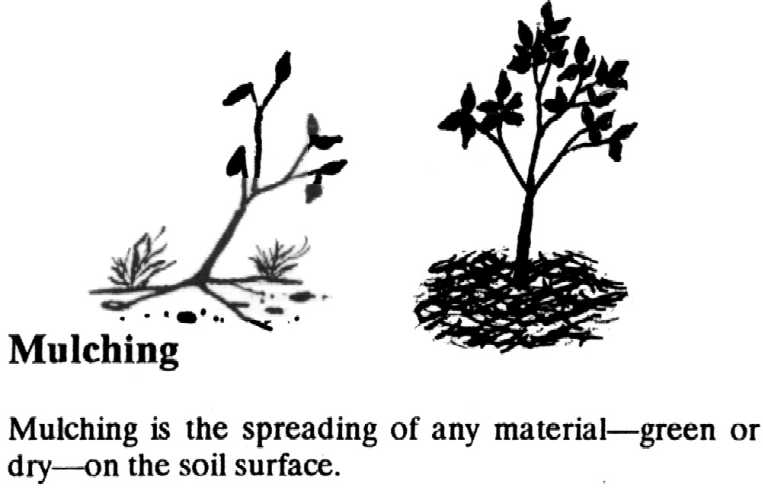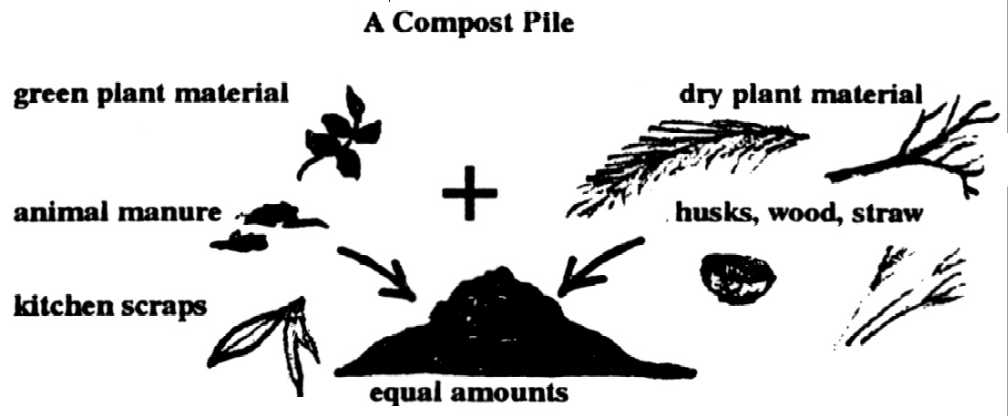
Managing Organic Matter: Composting and Mulching
Many farming activities interfere with-or even prevent the natural processes of nutrient and organic matter cycling. Some harvesting practices remove plant material or organic matter year after year while returning none to the soil. The inevitable result is a rapid decline in soil productivity. In some cases inorganic store bought fertilizers are then added in larger and larger quantities to sustain crop yields. In other cases, farmers must allow a soil to fallow or ‘rest’ for several years between relatively brief cropping periods. Both of these methods of soil maintenance are very costly, especially where land and/or cash is in short supply.
Agroforestry strategies that integrate trees with crops provide a variety of products and services depending upon species included, management techniques, etc. They do share one common objective sustaining the soil organic matter component.
The trees in all agroforestry systems, make continuous organic matter contributions to the soil. Scattered trees in fields, windbreaks, and live fences all shed leaves and branches. Trees in hedgerow intercropping systems are usually chosen and managed purposefully to maximize their organic matter contribution. Leaf material is frequently pruned and applied to cropping soil as green manure.
Some grasses and annual ‘cover crops’ are seeded and grown seasonally in fields to provide organic matter or ‘green manure’. Various Crotolaria and Sesbania species are grown in this way and then plowed into soils between cropping periods.
Organic matter management-returning organic matter to a soil as it is removed-can do wonders to increase and sustain a soil’s productivity. All of the properties of a highly productive soil are dependent upon the presence of organic matter:
- Soil fertility: Organic matter adds plant nutrients to the soil as it breaks down. It also provides sites for nutrients to bind to, holding them in upper soil layers where plants can use them.
- Soil structure: The slimes and microbial gums produced by decomposing organic matter bind soil particles. The result is a stronger, granular, more permeable and workable soil.
- Soil water holding capacity: A soil with good structure is more permeable and porous. Water infiltrates more easily and is held in small soil pores.
- Soil pH: Organic matter additions reduce the pH of excessively alkaline soils. The decomposition process releases hydrogen ions, increasing soil acidity.
Without regular organic matter addition, soils become drained of essential plant nutrients and unable to absorb or retain water. As their structure is weakened, soils are much more susceptible to the forces of wind and water erosion.
All trees, regardless of how they are arranged or managed, can be regularly harvested for organic matter. This plant material can then be applied to the soil surface around crops as mulch-or mixed with the soil in piles or pits to form compost.
 Mulching
Mulching
Mulching is the spreading of any material green or -dry the soil surface.
What are the benefits of mulching?
- Mulch controls weeds: A good layer of mulch shades the soil and prevents weeds from germinating.
- Mulch conserves soil moisture: It creates a barrier against the drying effects of sun and wind.
- Mulch fertilizes soil: As mulch breaks down, it releases essential plant nutrients.
- Mulch builds soil structure: As mulch breaks down, it makes the surface soil permeable and increases its water holding capacity.
- Mulch stops soil erosion: It protects soil from the erosive forces of wind and water. It shields soil from heavy raindrops and slows runoff water that flows over the soil surface.
What materials can you use for mulch?
- Plant materials: Leaves, small branches, coconut husks and stems, and wood chips all make good mulch. Whenever possible, cut or crush materials into small pieces. Smaller sized pieces produce a more effective mulch.
- Animal residue such as manure. Do not use fresh/wet manure as this can burn plant roots.
How do you apply mulch?
- Before planting: If you want to apply mulch before planting, spread the plant material about 4 cm thick over individual rows-or the entire area. Then just clear small areas for seed/seedlings and plant as usual. Do not cover newly sown seeds with mulch.
- After planting: If you want to mulch after planting just take care not to damage seedlings. If the plants or trees are already established, just pile mulch around the bases of trees in 1 m diameters.
Composting
Composting is the practice of mixing and piling plant and/or animal material with soil to form partially decayed, smaller particles of organic matter-or humus. Composting practices favor the micro-organisms that work-or break organic matter down into the proteins, starches and sugars of humus. Humus contains chemical and mineral substances in forms that plants can use immediately. Humus is also the form of organic matter that most directly adds to a soil’s productive properties.
What are the benefits of composting?
Composting simply speeds the organic matter breakdown process that occurs over time in nature when the same materials pile up in layers on the soil surface as mulch. Composted organic matter can be placed in direct contact with plant roots as a soil amendment or bedding material. Compost improves soil properties just as mulch does just more immediately and extensively. Compost is really just partially decomposed mulch. A soil that contains a lot of compost or organic matter is said to have a “spongy structure”. Such soil resists compaction and erosion. It captures and holds water, oxygen, and essential plant nutrients.
What materials can you use for compost?
- Plant materials: Leaves from trees or grass, animal manures, twigs, sawdust, wood-ash, and kitchen scraps all make good compost ingredients.
- Animal residues: Dry or wet manure can be used for composting.
How do you make compost?
Quite simply, you make compost by throwing of organic matter-and some soil into a big pile or pit.
Many consider composting an art and recommend special composting structures and various material layering techniques. Most recommend gathering all needed materials at once to form a complete pile. These techniques demand lots of time and labor.
You may not have enough material on hand to build a complete pile at once. You can also create a good compost pile over time, bit by bit. Making a good compost is not that tricky but there are some simple steps that will greatly speed the whole process:
- Add an equal ratio of green to dry material: Add dry stems, leaves and soil to your pile in equal measure with green plant material and manure.
- Keep compost moist: Build your compost pile in the shade and keep it covered with large leaves, coconut fronds, or a mat If it rains often enough you should not have to add any water. It is best to check the pile every few days to make sure it stays moist. It should not be too wet-just moist.
- Keep compost aired-provide oxygen: Turn/mix your pile once a week. The microbes that work the compost need oxygen.

All of the above will speed the process of organic matter decomposition by favoring the activity of the microorganisms responsible. A compost made and maintained like this will be ready for use about 6 weeks after the last ingredients are added.
How do you use the compost?
You can use the finished compost as a potting mix, a bedding mix, or a soil amendment. If your soil is really poor, you may want to raise demanding food crops such as vegetables, in beds or pots of only compost. This is a common practice on atolls where soil is often completely lacking in organic matter. You can also add compost to existing soil or dig it into the soil surrounding a plant.
You can also just dig holes next to fruit trees and periodically throw organic matter into them. This works where soils are well drained. If too wet, these pits may lack the oxygen required by the composting microbes.
Written by K.R. Dalla Rosa, Program Director for the Pacific, NFTA, 1010 Holomua Road, Paia, Hawaii 96779 USA
A publication of the Forest, Farm, and Community Tree Network (FACT Net)
Winrock International
Email: forestry@msmail.winrock.org
